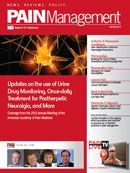Publication
Article
Pain Management
Looking at the Big Picture of Opioid Treatment for Migraine
Opioid analgesics are commonly prescribed for patients suffering with migraine, despite concerns over the risk of addiction, dependence, medication-overuse headache, and other factors.
Opioid analgesics are commonly prescribed for patients suffering with migraine, despite concerns over the risk of addiction, dependence, medication-overuse headache, and other factors.
Although opioid pain medications are not recommended as first-line therapies for patients with migraine, opioids are prescribed for many patients who cannot tolerate or do not respond to therapy with other medications. In “Opioid Use and Dependence among Persons with Migraine: Results of the AMPP Study” (http://bit.ly/GFx2Mz), published in January 2012 in Headache: The Journal of Head & Face Pain, the authors analyzed data from the 2009 American Migraine Prevalence and Prevention (AMPP) study in order to get a clearer idea of the rates of opioid use for acute migraine treatment, the demographics of the patient population for which these medications are prescribed, and the effect on patterns of health-care resource use.
For the study, the authors looked at a subset of patients from the AMPP study who met the International Classification of Headache Disorders criteria for migraine, and classified them into one of four groups: nonusers of opioids (no opioid use from 2005-2009), previous users (used opioids at least once from 2005-2008, no use in 2009), current nondependent users (used opioids in previous three months, but probably not dependent), and current probable dependent users (used opioids in previous three months, met DSMIV criteria for probable dependence on opioids). Of 5,796 respondents, 70% were classified as nonusers, 13.8% were previous users, 13.2% were current nondependent users, and 2.6% were current probable dependence users. Patients were also evaluated for sociodemographic data, headache frequency and duration, headache-related disability (using the Migraine Disability Assessment (MIDAS) questionnaire), medication use (in addition to opioids), medical and psychiatric comorbidities, and health care resource utilization (number of visits in previous 12 months to physicians and other providers).
Analysis of the data demonstrated:
- Opioid use was associated with older age, higher BMI, lower rates of currently being married and employed, and lower annual household income
- Average headache frequency in days per month was higher among current opioid users
- Previous and current opioid users “had significantly higher average MIDAS scores when compared to nonusers”
- Comorbidities “tended to occur at higher rates among all opioid-use groups compared to nonusers,” with depression “significantly more common among opioid-use groups compared to nonusers”
- Health-care resource use was higher among previous and current opioid users
Migraine Guidelines and Opioids
The American Academy of Neurology Practice Parameter: Evidence-based Guidelines for Migraine Headache (an update of which is currently in progress) cautions clinicians to guard against medication-overuse headache by limiting the use of opioids and other acute medications to “two headache days per week on a regular basis” (http://bit.ly/pT9uiF). Regarding the use of opioid medications as treatment for acute migraine, the guidelines note that “Butorphanol nasal spray is a treatment option for some patients with migraine” (evidence Grade A), and “may be considered when other medications cannot be used or as a rescue medication when significant sedation would not jeopardize the patient” (evidence Grade C). Clinicians are cautioned to give special attention to the risk of overuse and dependence when prescribing this medication. Parenteral opioids should be used for rescue therapy for acute migraine “when sedation side effects will not put the patient at risk and when the risk abuse has been addressed” (evidence Grade B). Combination oralparenteral opioids should be used in acute migraine “only when the risk of abuse has been addressed and sedation will not put the patient at risk” (evidence Grade A).
In their discussion of these results, the authors noted that although the “data demonstrate that opioid use is associated with multiple negative outcomes” in this population, the study had several limitations, and observers should use caution when attempting to make any claims regarding causality, and that it may well be likely that “the relationships between opioid use and many of the measured outcomes are bidirectional.” Still, these are potentially important findings. Given that opioids are widely used in migraine treatment, the fact that all opioid-use groups in the study fared worse than nonusers on several outcome variables underscores the importance of further exploring “the relationship between opioid dose and type and outcomes such as changes in migraine frequency, headacherelated disability, medical and psychiatric comorbidities, and health-care resource utilization.”





